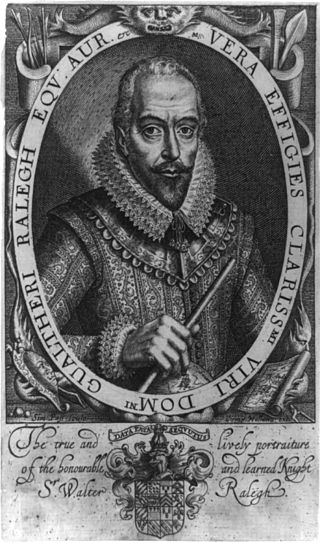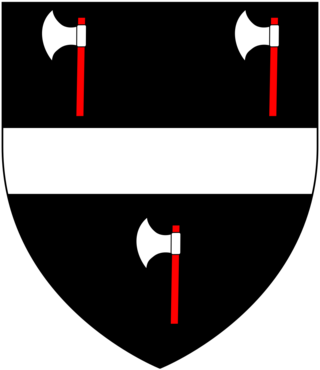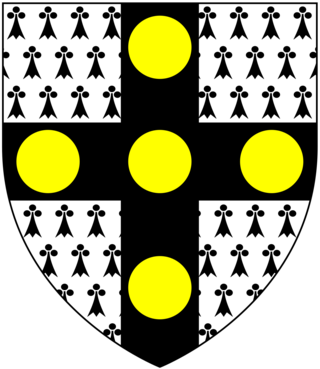Morshead baronets, of Trenant Park (1784)

- Sir John Morshead, 1st Baronet (1747–1813)
- Sir Frederick Treise Morshead, 2nd Baronet (1783–1828)
- Sir Warwick Charles Morshead, 3rd Baronet (1824–1905)
The Morshead Baronetcy, of Trenant Park in the County of Cornwall, was a title in the Baronetage of Great Britain. It was created on 22 January 1784 for John Morshead, Member of Parliament for Callington and Bodmin and Lord Warden of the Stannaries. The title became extinct on the death of the third Baronet in 1905.


Baron Grimthorpe, of Grimthorpe in the East Riding of the County of York, is a title in the Peerage of the United Kingdom. It was created on 17 February 1886 for the lawyer and architect Edmund Beckett, 5th Baronet, with remainder to the heirs male of his father. He was succeeded according to the special remainder by his nephew, the second Baron. He had earlier represented Grimsby in Parliament. As of 2014 the titles are held by the latter's great-grandson, the fifth Baron, who succeeded his father in 2003.

Baron St Levan, of St Michael's Mount in the County of Cornwall, is a title in the Peerage of the United Kingdom. It was created on 4 July 1887 for the former Member of Parliament Sir John St Aubyn, 2nd Baronet, becoming John St Aubyn, 1st Baron St Levan. He had previously represented Cornwall West in House of Commons as a Liberal and St Ives as a Liberal Unionist. He was succeeded by his eldest son, the second Baron, who was a Colonel and Honorary Brigadier-General in the Grenadier Guards. On his death the titles passed to his nephew, the third Baron, the son of the Hon. Sir Arthur James Dudley Stuart St Aubyn (1867–1897), second son of the first Baron. The third baron was succeeded in 1978 by his eldest son, the fourth baron, who had served with the Royal Navy at Dunkirk and in a minesweeper in Arctic Convoys during World War II and was awarded the Distinguished Service Cross (DSC). As of 2014, the titles are held by the fourth Baron's nephew, the fifth Baron, who succeeded in 2013.
Baron Vivian, of Glynn and of Truro in the County of Cornwall, is a title in the Peerage of the United Kingdom and held by a branch of the Vivian family. It was created on 19 August 1841 for the soldier Sir Hussey Vivian, 1st Baronet. He had already been created a baronet, of Truro in the County of Cornwall, on 19 January 1828. His eldest legitimate son, the second Baron, represented Bodmin in the House of Commons and served as Lord Lieutenant of Cornwall. His son, the third Baron, served as British Ambassador to Italy from 1891 to 1893. The latter's great-grandson, the sixth Baron, was a soldier and a Conservative member of the House of Lords. Lord Vivian was one of the ninety elected hereditary peers that were allowed to remain in the House of Lords after the passing of the House of Lords Act 1999. As of 2014 the titles are held by his only son, the seventh Baron, who succeeded in 2004.

Baron Chetwode, of Chetwode in the County of Buckingham, is a title in the Peerage of the United Kingdom. It was created in 1945 for the noted military commander Field Marshal Sir Philip Chetwode, 7th Baronet. As of 2014 the titles are held by his grandson, the second Baron, who succeeded in 1950. He is the eldest son of Captain Roger Charles George Chetwode, who was killed in the Second World War.

The Lord Warden of the Stannaries used to exercise judicial and military functions in Cornwall, England, UK, and is still the official who, upon the commission of the monarch or Duke of Cornwall for the time being, has the function of calling a stannary parliament of tinners. The last such parliament sat in 1753.
Sheriffs and high sheriffs of Cornwall: a chronological list:

There have been two baronetcies created for persons with the surname Hanson, both in the Baronetage of the United Kingdom. One creation is extant as of 2010.

There have been twenty one baronetcies created for persons with the surname Williams, eight in the Baronetage of England, three in the Baronetage of Great Britain and ten in the Baronetage of the United Kingdom. Only six of the creations are extant as of 2017.

Sir Charles Lemon, 2nd Baronet was a British Member of Parliament for several constituencies and a baronet.

The Wrey Baronetcy, of Trebitch in the County of Cornwall, is a title in the Baronetage of England. It was created on 30 June 1628 for William Wrey (d.1636), 2nd son of John Wrey of Trebeigh, St Ive, Cornwall, a member of an ancient Devon family. The third Baronet was a supporter of the Royalist cause and sat as Member of Parliament for Lostwithiel after the Restoration. He married Lady Anne, third daughter and co-heir of Edward Bourchier, 4th Earl of Bath, and a co-heir to the barony of Fitzwarine. The fourth Baronet represented Liskeard and Devon in the House of Commons. The fifth Baronet was Member of Parliament for Camelford while the sixth Baronet represented Barnstaple.

There have been two baronetcies created for members of the St Aubyn family, one in the Baronetage of England and one in the Baronetage of the United Kingdom.
The Vyvyan Baronetcy of Trelowarren, Cornwall is a title in the Baronetage of England. It was created on 12 February 1645 for Richard Vyvyan, a member of Parliament for Penrhyn, Tregony and St Mawes and Master of the Mint. His eldest son, the second Baronet, represented St Mawes and Helston in the House of Commons. He was succeeded in 1697 by his son, the third Baronet, was a member of Parliament for Mitchell and Cornwall and a prominent Jacobite. The eighth Baronet sat as Conservative Member of Parliament for Cornwall, Okehampton, Bristol and Helston. His grandson, the tenth Baronet, was a Colonel in the British Army. As of 28 February 2014, the present Baronet has not successfully proven his succession and is therefore not on the Official Roll of the Baronetage, with the baronetcy considered dormant since 1995.

The Molesworth, later Molesworth-St Aubyn Baronetcy, of Pencarrow near St Mabyn in Cornwall, is a title in the Baronetage of England. It was created on 19 July 1689 for Hender Molesworth, Governor of Jamaica. The second Baronet sat as Member of Parliament for Lostwithiel and Bossiney. The fourth Baronet represented Newport and Cornwall in the House of Commons. The fifth and sixth Baronets sat as Members of Parliament for Cornwall. The eighth Baronet was a prominent Radical politician and served as Secretary of State for the Colonies from July to October in 1855.

There have been three baronetcies created for persons with the surname Carew, two in the Baronetage of England prior to 1707, one in the Baronetage of Great Britain.

Sir John Trevelyan, 4th Baronet, of Nettlecombe Court in Somerset, was a British politician who sat in the House of Commons from 1777 to 1796.

Lieutenant-General Sir Alexander Campbell, 1st Baronet, was a senior officer of the British Army during the early nineteenth century. His long and varied career saw extensive action, including engagements in Europe during the American Revolutionary War, in India during the Fourth Anglo-Mysore War and subsequently in the Peninsular War as one of the Duke of Wellington's generals. Badly wounded during the Peninsular campaign, Campbell was rewarded with a knighthood and a baronetcy, later holding a number of prestigious military commands.

The Coryton Baronetcy, of Newton in the County of Cornwall, was a title in the Baronetage of England. It was created on 27 February 1662 for John Coryton, Member of Parliament for Callington, Cornwall and Launceston. He was the son of Sir William Coryton. The second Baronet represented Newport and Callington in Parliament. The third Baronet was member of parliament for Bossiney, Newport, Callington and Mitchell. The fourth Baronet represented Callington in Parliament. The title became extinct on his death in 1739.
The Rashleigh Baronetcy, of Prideaux in the County of Cornwall, is a title in the Baronetage of the United Kingdom. It was created on 30 September 1831 for John Rashleigh. The second Baronet sat as member of parliament for Cornwall East. The 6th baronet resides at Menabilly near Fowey, Cornwall, formerly the seat of his cousins the senior line of the Rashleighs of Cornwall since the 16th century.
Trenant Park is a Grade II listed country house in the civil parish of Duloe in east Cornwall, England, UK. It is surrounded by a large park and woodland. It is sited on a tongue of land between the East and West Looe rivers. The house was possibly built in the early 17th century, remodelled in the early 18th century, extended in the mid 19th century and divided into flats in the 20th century.